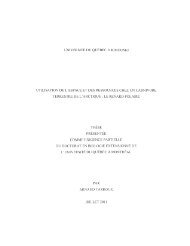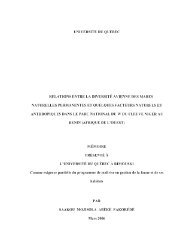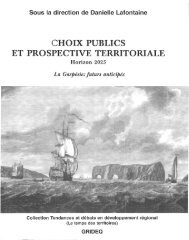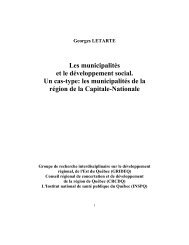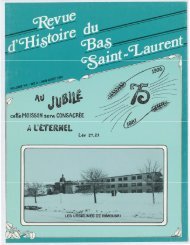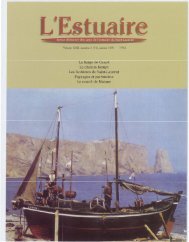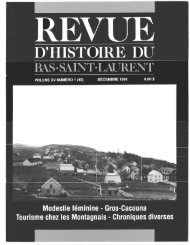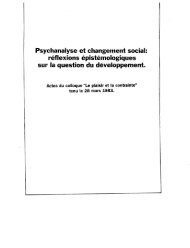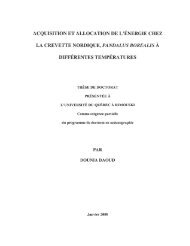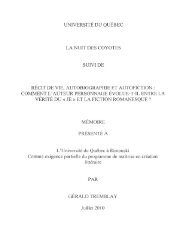influence du climat et de la prédation sur l'utilisation de l'habitat et la ...
influence du climat et de la prédation sur l'utilisation de l'habitat et la ...
influence du climat et de la prédation sur l'utilisation de l'habitat et la ...
Create successful ePaper yourself
Turn your PDF publications into a flip-book with our unique Google optimized e-Paper software.
60<br />
Body temperature (Tb) of the mounts was regul ated at 37.5 ± 0.3°C, whi ch is the core<br />
body temperature of winter ac<strong>climat</strong>ized free-ranging porcupines (D.W. Thomas,<br />
unpublished data). We moni tored temperature insi<strong>de</strong> the copper mounts usmg a copperconstantan<br />
thermocouple p<strong>la</strong>ced in the centre of the mount. We w rote a program for the<br />
Campbell CR-2 1 X to regul ate Tb' Power was applied automatically as 24V pulse to maintain<br />
body temperature. The datalogger mea<strong>sur</strong>ed voltage (Vm) every fi ve seconds, calcul ated the<br />
power consumption (see below), and stored the me an power over fi ve minute intervals. We<br />
calcul ated the power drawn by each mount (Pm) from Vm and the resistance of the heater wire<br />
circuit (R) fo llowing equati on 1:<br />
2<br />
P _ v'n m- R (1)<br />
with Pm expressed in Watts, Vm in Volts and R in Ohms.<br />
We recor<strong>de</strong>d m<strong>et</strong>eorological conditions in the stand while mounts were functioning by<br />
mea<strong>sur</strong>ing Tc w ith a copper-constantan thelmocouple p<strong>la</strong>ced insi<strong>de</strong> an anodi zed aluminium<br />
sphere, Ta w ith a copper-constantan thenTIocouple p<strong>la</strong>ced in the sha<strong>de</strong>, and wind speed with a<br />
portable hot-wire anemom<strong>et</strong>er (Seri es 440 Portable Air Velocity M<strong>et</strong>ers, Kurz Instruments).<br />
Mea<strong>sur</strong>ements were ma<strong>de</strong> 0.3 m above ground, averaged over fi ve minute intervals, and<br />
stored in the data logger. We obtained mea<strong>sur</strong>es of n<strong>et</strong> radiation from our automated weather<br />
stati on. We used synchronous mea<strong>sur</strong>ements of Tc, Ta, wind speed and n<strong>et</strong> radi ation to<br />
establish an equati on re<strong>la</strong>ting Tc to the other m<strong>et</strong>eorological param <strong>et</strong>ers (see below).<br />
We p<strong>la</strong>ced mounts in six microhabitats: "<strong>de</strong>n", "ground open", "ground covered,"<br />
"conifer open", "conifer covered', and "<strong>de</strong>ci<strong>du</strong>ous"(see Appendix J fo r a d<strong>et</strong>ail ed <strong>de</strong>scription<br />
of the mi crohabitats). We p<strong>la</strong>ced each mount fo r about 24 hours in one geographical site<br />
corresponding to one of the six microhabitats, and subsequently moved it to a new site. Since<br />
easily accessible sites were scarce in the study area, we used some sites on several occasions<br />
but took this into account in our analyses (see data analyses).<br />
Activity patterns<br />
We captured 26 a<strong>du</strong>lt porcupines (10 males, 16 females) in summer and fall 2003 and<br />
2004 . Indivi<strong>du</strong>als were immobilized fo llowing Morin & Bel1eaux (2003) and equipped with<br />
radio tra nsmitters (Lotek SMRC-5RB VHF transmitter, Lotek W ireless Inc.) (see chap. 2 fo r<br />
d<strong>et</strong>ails). ln January 2004 and 2005, we recaptured radi ocol<strong>la</strong>red porcupines to mea<strong>sur</strong>e their



